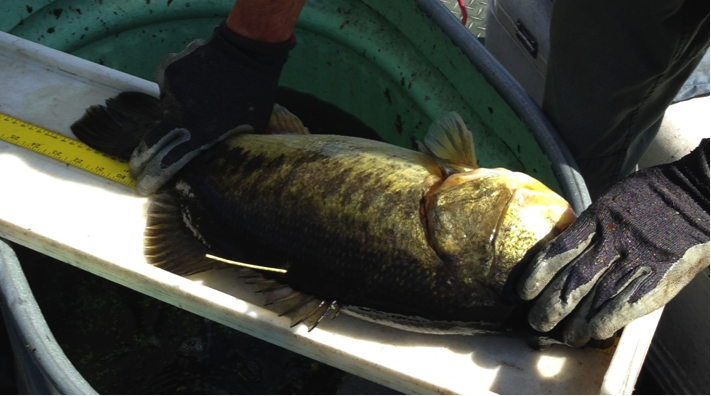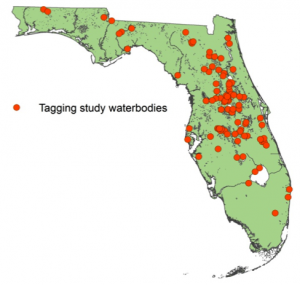November 25, 2014
By FWC Freshwater

By Andrew Dutterer
This basically goes without saying in the Sunshine State, but big bass are a big deal. Trophy bass provide a big part of the identity and draw of our state's bass fisheries. Florida is often touted as The Bass Fishing Capital of the World, and trophy-sized bass play no small role in this reputation.
Acknowledging the importance of trophy bass in Florida, the Florida Fish and Wildlife Conservation Commission (FWC) has recently initiated a resurgence in big bass research. As a major action item that was spawned out of Florida's Black Bass Management Plan in 2011, the FWC launched TrophyCatch, a trophy-bass documentation program that aids research and promotes conservation of trophy-sized bass. TrophyCatch was designed to address multiple goals for the FWC and its partners, but from a scientific standpoint the program is essentially building a database of where and when trophy bass get caught and released in Florida. As this dataset grows, it will allow the FWC to monitor trophy bass through time and across the state, which will aid in evaluating bass and habitat management actions such as stocking, habitat renovations, or changes to harvest regulations. This will ultimately expand our knowledge of how to grow and manage big bass for Florida anglers.
Angler recognition programs, like TrophyCatch, are not exactly new – other states, including Florida (see Big Catch), have been conducting them for years. However, the FWC has set TrophyCatch apart from other programs by pairing it with a tagging study to ground truth its data.
The trophy-bass tagging study began one year prior to TrophyCatch's launch. Across the state, FWC biologists have been working together to tag every bass 8 pounds or heavier that we sample during electrofishing surveys, which allow live-release of the bass. Each year, we have tagged nearly 200 bass, and to date, the project has reached more than 95 water bodies across the state, all of them public. This is similar to the broad spatial scale at which TrophyCatch operates, although TrophyCatch also includes bass legally caught from private waters.

Tagging studies, like this, perform two fundamental functions that mesh together to produce results. One, they create a sub-population of tagged fish that acts as a scaled-down model of the overall population. What happens to our tagged population is considered to be representative of what happens to the overall population. Just like an election poll, a sub-set of individuals is used to predict outcomes for the entire population. Two, it connects anglers who catch tagged bass with scientists who are studying them. To ensure that most anglers report any tagged bass they catch, tag rewards in our study are worth $100.
After catching a tagged bass, anglers report their catch via a telephone number printed on the tag and answer some questions. A primary interest of this study is to determine the fate of tagged fish -- was it released or harvested? We also ask if the angler is aware of TrophyCatch and if the angler plans to document his or her tagged bass with the program. Results from tag returns provide insights into what likely happened within the overall trophy-bass population. For example, if we have 100 tagged bass at large for our sub-population and 25 were caught and 10 were harvested that would indicate an annual catch rate of 25% and an annual exploitation rate of 10%. In other words, that would mean that 25% of all bass are caught each year, but only 10% of them get harvested, on public waters.
What we've found so far is that from a state-wide standpoint the trophy-bass fishery in Florida operates with a lot of similarity in fishery rates as we see for average-sized bass. In this study we've measured annual catch rates around 20-25%, so about one in four or five trophy bass in Florida gets caught each year. This is interesting because a lot of anglers tend to think of trophy bass being hard to catch because of different behavior or above average intelligence. However, this statistic suggests that trophy bass are just as susceptible to being caught as their smaller brethren, but being much less abundant, they are a rarity among most anglers' catches. Very few of Florida's trophy bass actually end up on a plate or on the wall. Annual exploitation rates have ranged from 2% to 5%, meaning that out of 100 trophy bass at large, only two to five were harvested after being caught each year. This is pretty low and likely a little lower than what we observe in smaller bass. This is largely due to high voluntary release rates for big bass. Tagging has shown that about 80% to 90% of trophy bass that were caught were released. These results reiterate that in Florida the catch-and-release ethic among bass fishermen is strong, especially when it comes to trophy bass. Releasing these rarer, older female bass is much more important than releasing abundant young bass that in some cases compete with one another for food reducing the population's growth rate, which is an important factor in considering new statewide bass rules.

The trophy-bass tagging study has also proved to be a great way to measure the reach and growth of the TrophyCatch program. We measured a big jump in anglers who are aware of TrophyCatch from its first to second year of operation (31% ? 55%) and an even bigger jump in anglers' participation rate in the program (6% ? 24%). These data are great news in that they show growth in the TrophyCatch program. However, because awareness and participation rates are not equal, it indicates that there are anglers who catch big bass and know about TrophyCatch, but choose not to participate. A major reason may be not having a camera and scale with them to document the catch, so getting word out about the requirements is important. We want as a many legitimate trophy bass as possible to get recorded in the TrophyCatch dataset, and through outreach and communication with our anglers, we hope to see continued growth in the program and less disparity between awareness and participation rates.
From the standpoint of fisheries researchers and managers, pairing TrophyCatch with the trophy-bass tagging study has been exciting and provided useful new information. Because the tagging study informed us about participation rates for TrophyCatch, we can calculate what fraction of all trophy bass caught in Florida the last two years landed in the TrophyCatch records. This allows us to estimate the total number of trophy bass that were caught from public waters in the entire state. Likewise, the tagging study allowed us to estimate the fraction of all trophy bass that were entered into TrophyCatch, and in turn allows us to estimate the number of bass 8 pounds or heavier that existed in state public waters each of the last two years. The data tell us that about 3,000 out of 21,000 total trophy bass swimming in state waters were caught during Year-1 of TrophyCatch (October 2012 – September 2013), and in Year-2 (October 2013 – September 2014) about 3,300 out of 16,000 were caught. Honestly, these numbers were a little less than most of us probably would have guessed, but we hadn't estimated trophy-bass catch or abundance until now. The fact that our estimates were similar between years, especially given that TrophyCatch participation rate changed, gives us assurance in our methods. Confidence limits on our Year-2 abundance estimate suggested trophy-bass abundance could have ranged between 8,600 to almost 44,000. Through time, and as TrophyCatch participation increases, we expect our precision in estimating trophy-bass catch and abundance to increase.

Total trophy bass catch and abundance in Florida are great metrics to have and should prove useful in a number of ways. First, they can help the folks behind the scenes at TrophyCatch and the program's corporate sponsors prepare for the increased volume of submissions that are likely to come as participation in the program grows. It probably wouldn't be unreasonable for last season's verified entries (991) to double or triple in coming years. Second, having an estimate of catch and abundance of trophy bass allows us to delve into economics of Florida bass fishing from a trophy-bass perspective and consider per capita value. Florida's bass industry was estimated to have a $1.25 billion dollar economic impact in 2011. If we were to boil down the state's bass fisheries to only consider trophy-sized bass, it would result in economic values of $60,000-70,000 per trophy bass. Plus, putting a number on the finite number of trophy bass we have in Florida may cause trophy-bass conservation to resonate a little louder with anglers. Lastly, having these estimates will provide a way to evaluate large-scale bass management actions. For instance, the FWC is in the process of considering a proposed new statewide bass harvest regulation, which has been tailored partially to foster growth of more trophy bass. Tracking catch and abundance of trophy bass via TrophyCatch and the tagging study should provide a great gauge of its effects, if the rule is implemented.
Meanwhile, TrophyCatch and the trophy-bass tagging study will continue to keep a finger on the pulse of Florida's trophy-bass fisheries. To register and get familiar with the submission procedures for TrophyCatch, please check out the website today. It's a great way to get involved in science and conservation for trophy bass in Florida. If you happen to catch a tagged bass, clip the tag close to the bass's body and retain the external end for record keeping. It has a unique identification code and telephone number (850-363-6037) for reporting your catch and collecting the tag-return reward.
